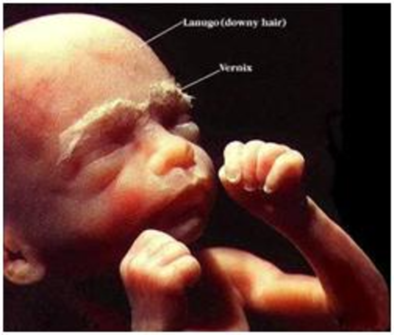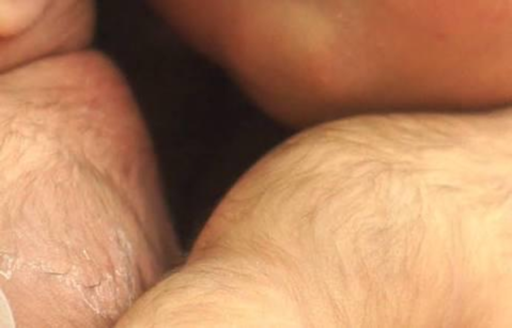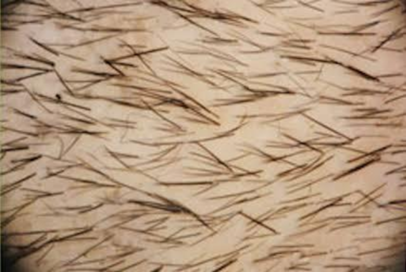
Three kinds of hair, including fetal and adult types
INTRODUCTION:
Hair is a slender filament grows from hair follicle made up of keratinized cells.
EXPLANATION:
There are three kinds of hair including fetal type and adult type. They are
1. Lanugo
2. Vellus
3. Terminal hair
Lanugo:
They are fine, downy, unpigmented hair which appears on the fetus in the last 3 months of fetal development. After birth, most of the lanugo is replaced by vellus hair.

 Vellus:
Vellus:
The vellus hair is the fine, pale hair which replaces lanugo by the time of birth. It presents except on eyebrows, eye lashes and hair of the scalp. It is seen two third in women, one tenth of men and all over in children.

Terminal hair:
These are the longer, coarser and more pigmented type of hair. These type of hair forms eyebrows, eyelashes and scalp. It is also seen in axilla and pubis after puberty.

CONCLUTION:
Hairs are seen in everywhere in the body except palms and sole. The density and pigmentation differs in male and female.
Want to see the full answer?
Check out a sample textbook solution
Chapter 6 Solutions
Anatomy and Physiology
Additional Science Textbook Solutions
LooseLeaf for Integrated Principles of Zoology
Anatomy & Physiology
Campbell Biology (10th Edition)
Human Anatomy & Physiology (2nd Edition)
Human Biology: Concepts and Current Issues (8th Edition)
Biology: Concepts and Investigations
- This is an image of skin. Identify "4" sweat gland hair follicle melanocyte sebaceous gland 4arrow_forwardPartial or complete lack of hair due to genetic factors, aging, chemotherapy or skin diseases is known as?arrow_forwardPlease answer together 1. Patient A and Patient B suffered different degrees of burn during an accident. Patient A had only the epidermis layer destroyed, while Patient B had both the epidermis and the dermis layers destroyed. Without skin grafting, will body hair grow back on Patient A? How about Patient B? Explain 2. Name 3 different types of accessory structures in the skin that play an important role in maintaining homeostasis? Give specific examples to show how these accessory structures can maintain homeostasis through negative feedback.arrow_forward
- The hair present only prenatally is called most of which is replaced by by the time of birth. lanugo; vellus O pilus; terminal hair vellus; lanugo vellus; terminal hairarrow_forwardQuestions :Which portion of the hair contains cells that actively undergo mitosis. Answers: 1. Shaft 2. follicle 3. matrix 4.cuticlearrow_forwardHidradenitis suppurativa is a chronic hair follicular occlusive disease that is believed to be initiated by abnormal keratinocyte differentiation and failure of keratinocytes to shed from which of the following areas of the skin? C- D por D CTS ERS FIRS CO CU Barrow_forward
- ulling the hair out can be quite painful, yet cutting hair is not. Explain.arrow_forwardObserve and describe the changes of the skin during the following activities: 1. Playing games (e.g. Volleyball) in an open court on a sunny day.2. Prolonged stay inside a cold room.3. Hair in different parts of the body (head, axilla, limbs, and pubic)4. Hair of the head after drying up (shampooed or without shampoo).5. The nails of a baby and an elderlyarrow_forwardplease provide atleast 3 identifiction that can diffrenciate nornmal skin cell from melanin tumor skin cell photo is attached below for your refrencearrow_forward
- Skin Accessories Label the parts of a hair follicle: Sebaceous gland * Hair shaft * Hair bulb * Hair root * Hair papilla Label the parts of a nail: Eponychium * Free edge * Hyponychium * Lunula * Nail matrix * Nail root * Lateral nail fold * Nail bed * Nail plate. 11 7 12 1 8 13 2 5 3 9. 10 14 4arrow_forwardBelow is a picture of the base of a hair. The section that is referred to as the matrix is shown in the section. O yellow brown red O purplearrow_forwardYou develop a callus on the bottom of your hallux from a pair of ill-fitting shoes, and you feel the pain of an Onychocryptosis on the same hallux. clusive se 1. Describe both conditions and their symptoms using proper terminology. 2. To treat the callus, you decide to shave off some of the excess epidermis. While doing this, you notice that there is no pain or bleeding. Why wouldn't it cause pain to remove only the superficial part of the epidermis? Why wouldn't it bleed? 3. Unfortunately, you go a bit overboard and feel a sudden pinch, after which you notice you are bleeding. What has happened? Are you still in the epidermis? Explain. 4. A treatment for Onychocryptosis is to remove the nail and apply a chemical such as phenol to the cells of the nail matrix, which kills the cells. What effect will killing the cells of the nail matrix have on the nail? Explain.arrow_forward


